The Best Things To Do in Porto
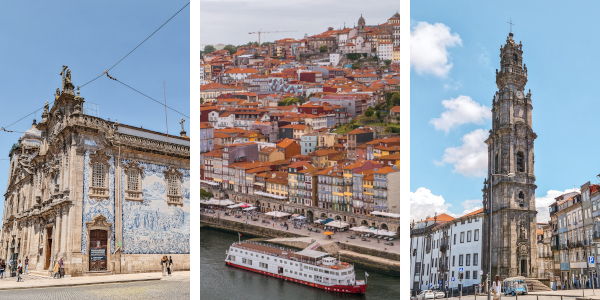
From Beautiful Architecture to Stunning Views And More
Porto is located in the north of Portugal and is the second-largest city in Portugal. The historic center is one of the oldest European centers and was designated as a UNESCO World Heritage Site in 1996. Besides that, Porto is also famous for its wine with their Port wine even being named after the city. In the last few years, Porto became an increasingly popular travel destination, partly due to winning a few travel awards including the award for “Best City Destination” in 2022. We can see why Porto! The city is filled with well-preserved historical buildings and the most scenic views and, most importantly, the city is able to retain its charm without feeling too touristy (at least to this date). In this blog post, we will explore the best things to do in Porto, so you can make the most of your trip to this beautiful city. Porto quickly became our favorite city in Portugal and we’re sure it will capture your heart too!
Take a stroll along the Douro River in the Ribeira District
The Ribeira District in Porto is one of the most charming and picturesque neighborhoods in the city. Located on the banks of the Douro River, this historic district is known for its colorful buildings, lively atmosphere, and stunning views of the river. Be prepared for climbing stairs, as there are many in the Ribeira District. The riverside promenade allows for a stroll along the water’s edge, taking in the views of the Dom Luís I Bridge and the town across the river. There are also numerous restaurants and bars along the promenade, where you can have a meal or drink while enjoying the scenery. Alternatively, you can also go on a boat tour along the Douro River and admire Porto and its bridges from another perspective.
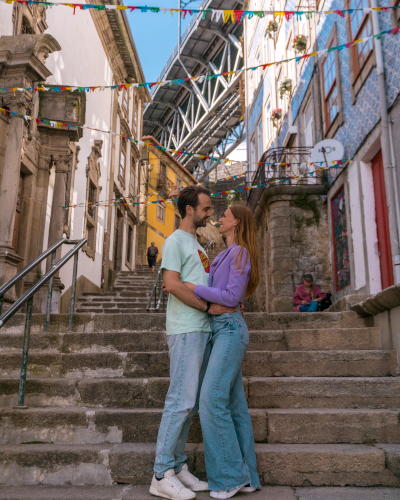
Climbing the many stairs in the colorful Ribeira District

View of the Ribeira District from the Dom Luís I Bridge
Dom Luís I Bridge
The Dom Luís I Bridge, or Ponte de Dom Luís I, is one of the most iconic landmarks in Porto, spanning the Douro River and connecting the city with its neighbor across the water, Vila Nova de Gaia. The bridge is a stunning feat of engineering, with two levels that carry both vehicle and pedestrian traffic. The bridge is named after King Luís I, the king of Portugal at the time of construction, which was from 1881 until 1886. The bridge is designed by Théophile Seyrig. Fun fact: Seyrig founded the company G. Eiffel and Cie together with Gustave Eiffel. Yes, that’s the same Eiffel from the Eiffel Tower in Paris. Seyrig left the company in 1879 because he was dissatisfied with the distribution of the profits.
It’s a double deck bridge and for centuries, the bridge carried vehicle traffic on both decks. Nowadays, the lower deck is for pedestrians only and the upper deck carries a metro railway and pedestrian walkways. Vehicle traffic isn’t allowed anymore on the Luís I Bridge. From the top level of the bridge, you can enjoy amazing panoramic views of the river and the city. This is a must-do in Porto!
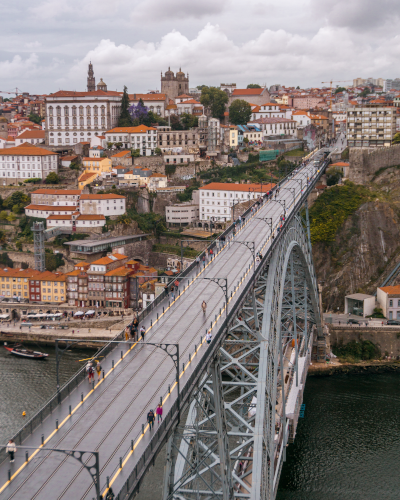
The Dom Luís I Bridge
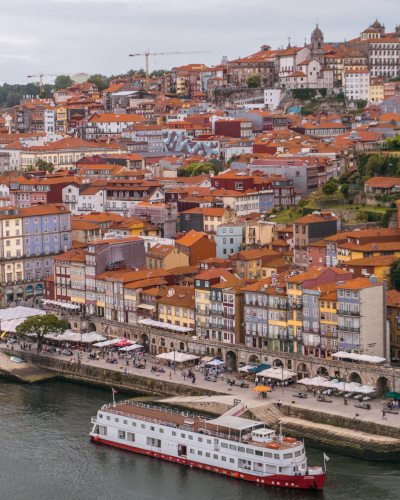
View from the Dom Luís I Bridge
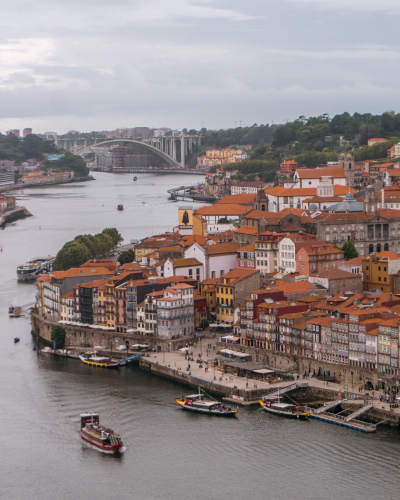
View from the Dom Luís I Bridge
Vila Nova de Gaia
Vila Nova de Gaia, commonly referred to simply as Gaia, is the town across the Douro River from Porto. Although technically a separate municipality from Porto, the two cities are connected by numerous bridges and are often considered part of the same metropolitan area. Gaia is perhaps best known for its Port wine cellars, which are located along the riverfront and where you can sample some of the region’s most famous Port wines. Many of these cellars have been in operation for centuries and offer guided tours and tastings.
Right after crossing the Luís I Bridge, the Mosteiro da Serra do Pilar is on your left. This former monastery dates back to the 17th century and, because of its location, offers incredible views of Porto and the Luís I Bridge. We’d highly recommend walking the path up to the viewing platform right in front of the monastery’s round church.

View of Porto from the monastery’s viewing platform
A fun way to get down to the riverside of Gaia is by taking the cable car. As you go down, you’ll be treated to breathtaking views of the Douro River and the historic buildings that line its banks. A one-way ticket is €6 and a return ticket is €9. The trip lasted 5 minutes and we didn’t experience any wait times.
Opening hours of the Gaia Cable Car
Summer: from 10:00 until 20:00
Spring & Fall: from 10:00 until 19:00
Winter: daily from 10:00 until 18:00
Check this website for the current opening hours.
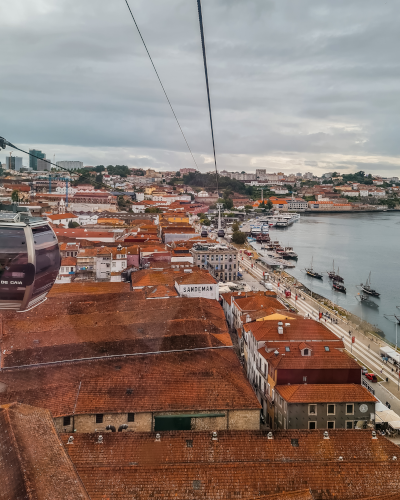
The cable car ride in Gaia
Porto Cathedral
The Porto Cathedral, also known as the Sé do Porto, is one of the city’s oldest monuments. Construction of the cathedral started in the 12th century and lasted centuries. The cathedral was originally built in Romanesque style, with Baroque and Gothic alterations made later. Unlike other churches in Porto, the exterior of the Porto Cathedral lacks decorations. The interior, however, does not, and was greatly altered during the Baroque period.
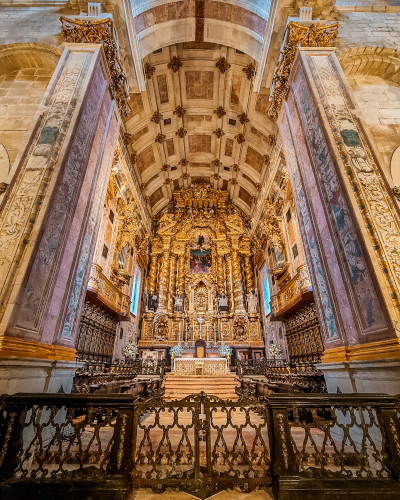
The Baroque altarpiece in the Porto Cathedral
The building with white walls connected to the cathedral is the cloister. This Gothic cloister has a courtyard that’s surrounded by galleries decorated with beautiful Baroque Azulejos. When visiting the cloister, you can also enter the interior rooms, which is very rare. The interior rooms are lavishly decorated, with a lot of marble and gold.
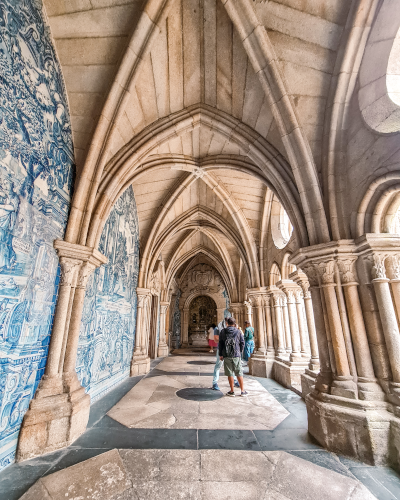
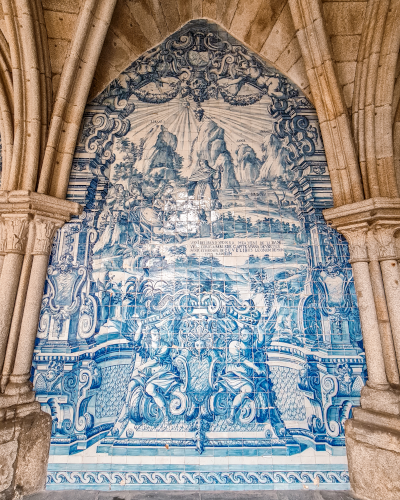
The cloister’s courtyard galleries with Azulejos
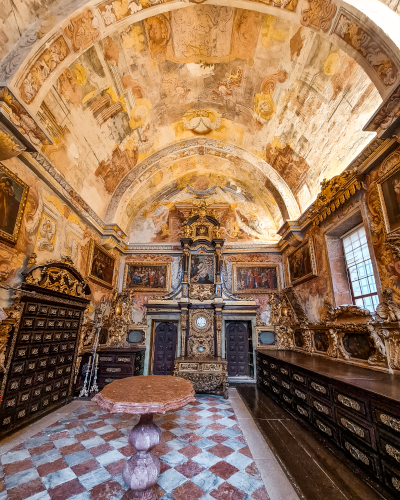
The lavishly decorated interior room of the cloister
You can also climb the towers of the cathedral and watch the view of Porto from up there. As it was pouring during our visit and we were already soaking wet, we didn’t feel like going up there.
Visits to the cathedral are free, but the entrance fee for the cloister is €3. In our opinion, this is well-worth it. We specifically loved the Azulejos galleries, and it’s just a great experience to see the cathedral and the cloister from the inside. If it’s not raining, we bet seeing the view from the tower is great too.
Opening hours of the Porto Cathedral
April - October: daily from 09:30 until 18:30
November - March: daily from 09:30 until 17:30
Igreja Paroquial de Santo Ildefonso
Igreja Paroquial de Santo Ildefonso, or the Church of Saint Ildefonso, was built in the 18th century, and is known for its stunning Azulejos. The church was built on the site of the Chapel Santo Alifon, which was demolished in 1709 due to danger of collapsing. The exterior of the church is adorned with roughly 11.000 Azulejos, which were designed by artist Jorge Colaço and installed in 1932. These tiles portray various scenes from the life of Saint Ildefonso, as well as figurative images from the Gospels.
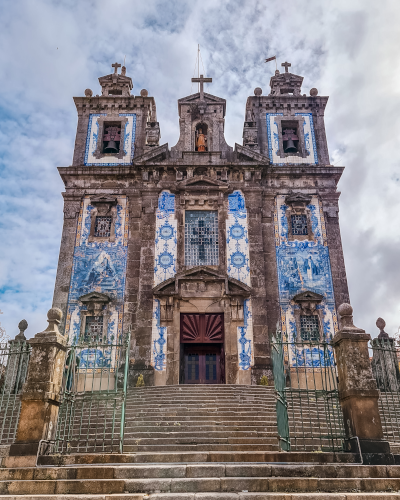
Igreja Paroquial de Santo Ildefonso
Opening hours of the Igreja Paroquial de Santo Ildefonso
Monday: from 15:00 until 18:30
Tuesday - Saturday: from 09:00 until 12:00 and from 15:00 until 18:30
Sunday: from 09:00 until 13:00 and from 18:00 until 20:00
There’s no entrance fee.
São Bento Station
São Bento Station is not only Porto’s train station but also an iconic landmark. The station was built in the early 20th century on the site of a former monastery. The exterior of the building is designed in the Beaux-Arts style, which was very popular in France at that time. The interior however, is what sets this train station apart from other train stations. The station’s hall is beautifully decorated with approximately 20.000 Azulejos, designed by Jorge Colaço (the same artist from the Azulejos on Igreja Paroquial de Santo Ildefonso). It took 11 years to complete the tile project. The Azulejos depict important moments in Portugal’s history, such as the Battle of Valdevez and the Conquest of Ceuta. Be aware that the hall can be filled with people. Train stations are always busy, but São Bento Station is extremely crowded because it’s not only a transportation hub, but also a popular tourist attraction. Nevertheless, it’s very much worth checking out the beautiful Azulejos in the hall.
If you’re looking for a unique experience, consider booking a traditional Portuguese Fado concert in the São Bento Station.

Azulejos depicting the Battle of Valdevez in São Bento Station
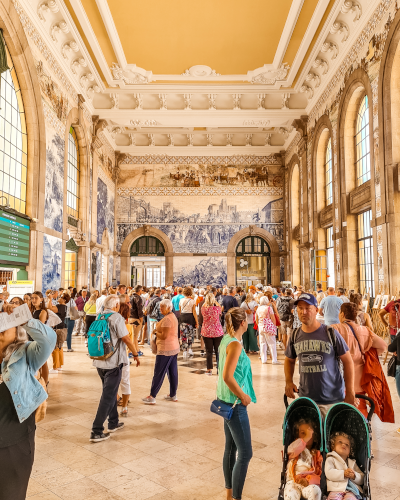
São Bento Station
Clérigos Church and Tower
The Clérigos Tower is one of the most iconic landmarks in Porto and with an impressive height of more than 75 meters, the tower is visible from different points in the city. It’s actually one of the tallest buildings in Porto. The church and tower were built in the 18th century and were designed by Italian architect Nicolau Nasoni in Baroque style. The church was built at the request of the Brotherhood of the Clérigos (Clergy), which is also where the name comes from. It’s possible to visit both the church and the tower. When visiting the tower, you’ll walk through the House of the Brotherhood, which currently is a museum showcasing religious pieces dating from the 13th until the 20th century. After climbing 225 steps, you’re greeted to a stunning 360 degree view of the city and the Douro River. It’s well worth the effort and a must-do in Porto!
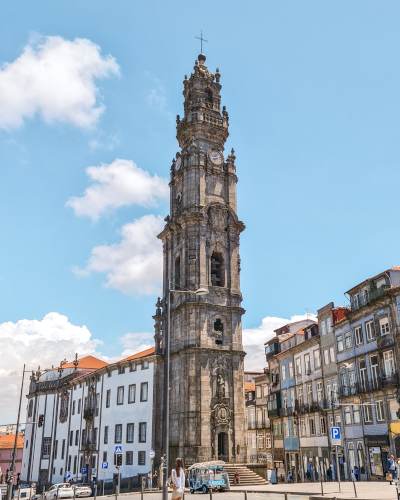
Clérigos Tower
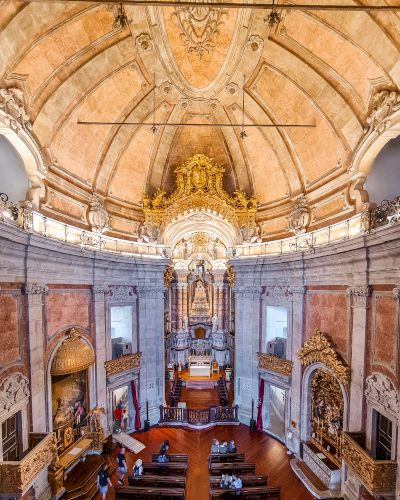
Interior of the Clérigos Church
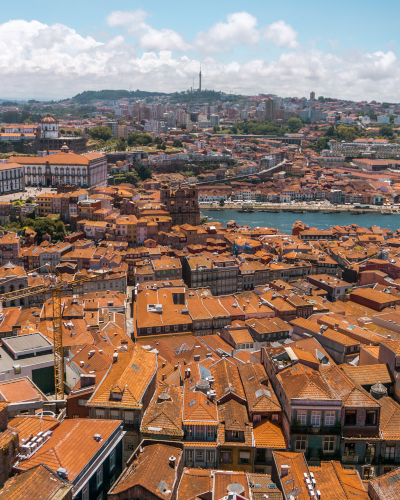
The stunning views of Porto from the top of the Clérigos Tower
Opening hours of the Clérigos Church and Tower
Daily: from 09:00 until 19:00
There’s no entrance fee for visits to the church.
An entrance ticket for the Clérigos Tower is €8 and includes a visit to the museum. You can buy tickets online or at the ticket office in the tower. As they work with time slots, you might have to wait a bit for the start of your slot when buying tickets at the ticket office. Therefore, we’d recommend buying tickets for the Clérigos Tower online.
Livraria Lello
Livraria Lello is considered the prettiest bookstore in the world and is a very popular tourist attraction in Porto. It’s one of the oldest bookstores in Portugal dating back to 1881. The uniquely designed Neo-Gothic building features Art Nouveau and Art Deco elements on the interior. When entering the bookstore, your attention is immediately drawn to the iconic staircase in the middle of the store. It looks like the staircase is made from wood, but it’s actually made out of reinforced concrete, making it a very strong and safe staircase. Fun fact: during renovations in 1993, the stairs were painted in this crimson red color by mistake, instead of their original color brown. Because the renovation master liked the red color, they left it this way.
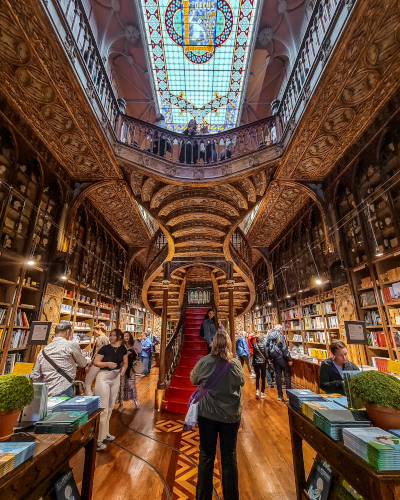
The iconic staircase in Livraria Lello
After climbing the stairs, take a moment to admire the stained glass ceiling window. The ceiling window was designed by the Dutch stained glass master Samuel Van Krieken. Traditionally, a subtle detail is added to the stained glass window during every restoration which refers to that period of time. During the restorations of 2018, a smiling emoji is added to the stained glass. You have to look very closely to notice it.
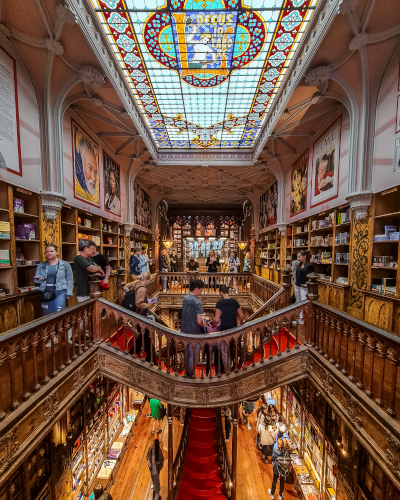
The stained glass window in Livraria Lello
We’d highly recommend buying tickets in advance for Livraria Lello, preferably for the first time slot available. If you want to enjoy the bookstore in as much peace as possible, we’d advise getting there at least 30 minutes before opening as the lines get crazy really quickly. Even when you have a ticket with a time slot, you have to wait in line. There’s a separate line for people without tickets, which is even longer. You can buy tickets on the website of Livraria Lello.
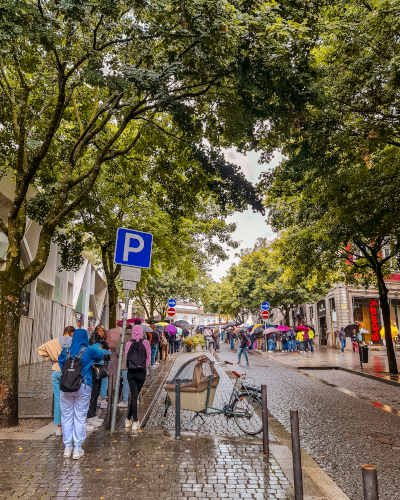
The line for Livraria Lello at 11:00
Opening hours of Livraria Lello
Daily: from 09:30 until 19:00
Closed on December 25th, January 1st, Easter Sunday, May 1st and June 24th.
An entrance ticket is €8. The ticket is also a discount voucher when you buy a book in the bookstore (they actually sell books too, it’s not only a tourist attraction, haha). They have special Livraria Lello editions of some of the most popular books of all time, which is a great souvenir to bring home.


The souvenir from Livraria Lello we brought home
Igreja do Carmo
Igreja do Carmo is a Baroque church dating back to the late 18th century. The Azulejos on the side facade of the church represent scenes of the founding of the Carmelite Order, a catholic religious order that emerged in the 11th century in the region of Mount Carmel. The Azulejos date back to 1912. Because of the Azulejos decorations, it’s widely considered to be one of the most beautiful churches in Porto and we can see why. We simply love the Portuguese Azulejos!

The Azulejos on the side facade of Igreja do Carmo
The building left to Igreja do Carmo looks like it’s part of Igreja do Carmo, but it’s actually a different church: Igreja dos Carmelitas Descalços. If you look closely, you can tell that both churches are separated by one of the world’s narrowest houses. Apparently, the house was built to prevent any contact between the nuns and the monks.
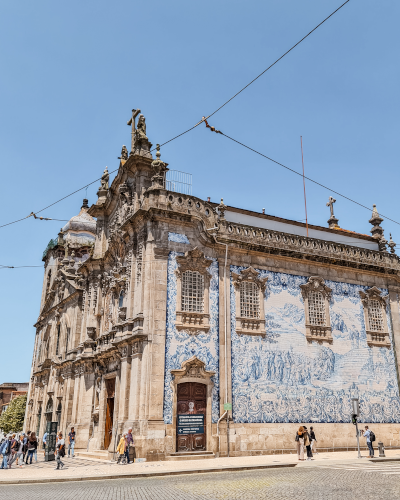
Igreja do Carmo
Opening hours of Igreja do Carmo
Monday - Friday: from 07:15 until 19:00
Saturday, Sunday & Holidays: from 09:00 until 18:45
Igreja dos Carmelitas Descalços has the same opening hours. There are no entrance fees.
Capela das Almas
Capela das Almas, or the Chapel of Souls, is a small but beautiful chapel located in the heart of Porto. The chapel is known for its stunning exterior, which is completely covered in Azulejos. Until 1929, the exterior of the chapel was actually white-plastered without any tiles. Currently, the facade is decorated with 15.947 Azulejos covering around 360 square meters of wall. The tiles covering the chapel were designed by Eduardo Leite and represent the steps in the life of Saint Francis of Assisi and Saint Catherine.

The facade of Capela das Almas
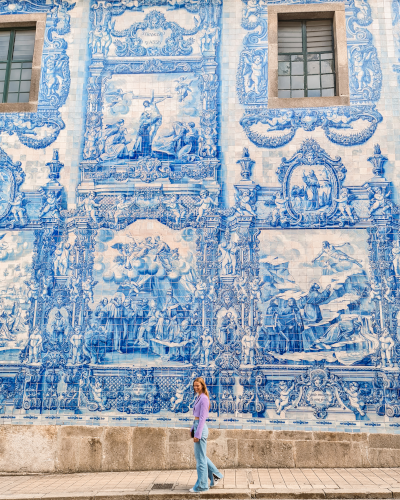
The side facade of Capela das Almas is completely covered in Azulejos
Rua de Santa Catarina
Closely located to Capela das Almas you’ll find Porto’s main shopping street Rua de Santa Catarina. A large part of the street is for pedestrians only, providing a safe and pleasant shopping experience. The historical buildings in the street house different kinds of stores, cafes and restaurants. There’s even a shopping mall located in Rua de Santa Catarina called Via Catarina. It’s a great area to do some shopping or to have a drink and/or bite.
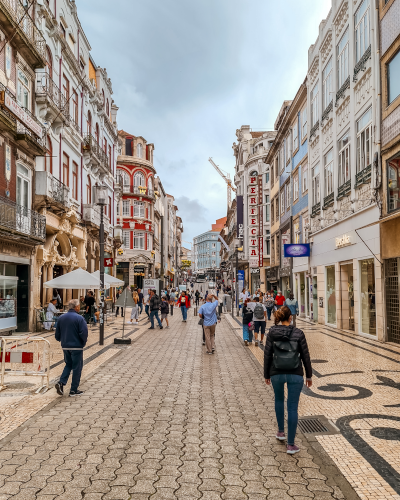
Rua de Santa Catarina
LIFT Rooftop
LIFT Rooftop is a rooftop bar located on the top floor of the Via Catarina shopping mall. This hidden gem is a great place for an afternoon drink or an evening night out. It’s a little hard to find as there are no clear signs indicating where to go, but we’re going to explain exactly how to get there. Head inside the Via Catarina shopping mall and take the escalators to the 4th floor. On this floor, you’ll find the food court and all restaurants of the mall. Look for McDonald’s or follow the “Parking” signs. The “Parking” signs will lead you to the specific elevators on the 4th floor that go all the way up to the top of the building. These elevators are located in a hallway to the right of the McDonald’s. Click the 14th floor button in the elevator and there you go, you made it to Porto’s best rooftop bar.
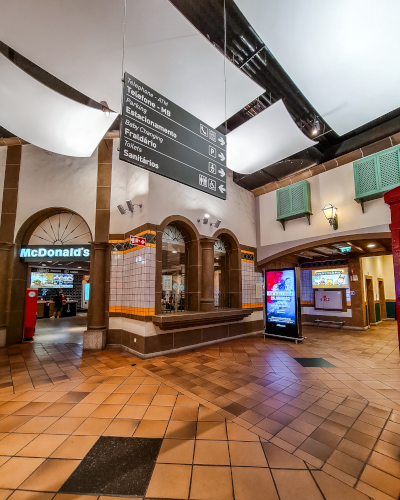
The “Parking” sign and McDonald’s on the 4th floor of Via Catarina shopping mall
LIFT Rooftop has a relaxed vibe with lounge music and, of course, offers amazing views of Porto. There are bean bags for those who want to get really relaxed, but you can also sit at a table. You can order drinks and snacks at the counter. When ordering food, you receive a timer so you know when the food is ready to pick up. Their menu offers a nice selection of snacks that’s perfect for sharing. We can highly recommend watching the sunset from this rooftop as it’s absolutely magical.
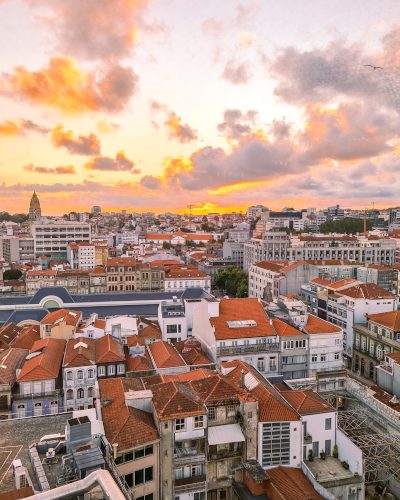
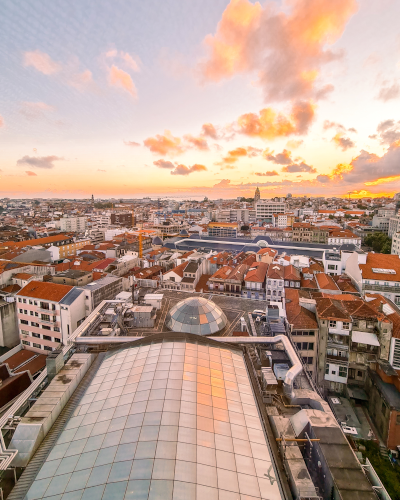
The views from LIFT Rooftop
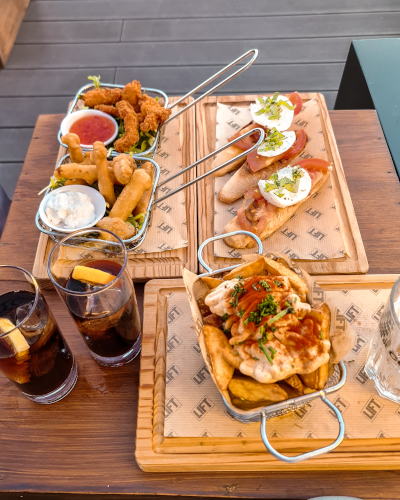
Food and drinks at LIFT Rooftop
Majestic Café
Majestic Café is located in Rua de Santa Catarina and is by far the most beautiful café in Porto. The café dates back to 1922 and was designed by architect José Pinto de Oliveira. Both the exterior and the interior are beautifully designed in Art Nouveau style, reminiscent of the cafés in Paris at that time. The facade is ornamented with floral elements and winding shapes. Inside, there are curved Art Nouveau details everywhere, such as the walls that are covered with curved wooden frames and large windows. Majestic Café is absolutely worth visiting if you’re into beautiful cafés.

The facade of Majestic Café
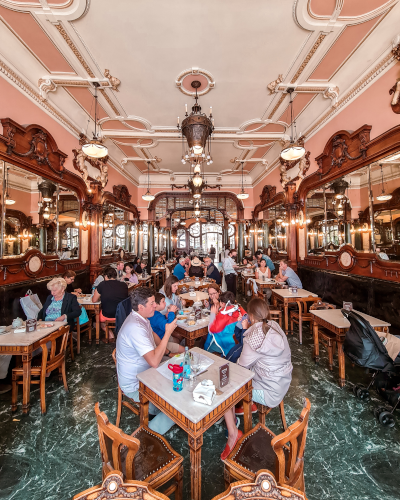
The interior of Majestic Café
Majestic Café isn’t only reminiscent of 20th century Parisian cafés in looks. Their prices are also very similar. A simple espresso in Majestic Café is €5, which is very high for Porto standards.
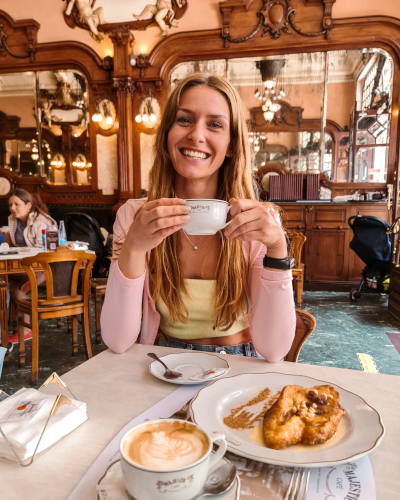
Coffee break in Majestic Café
Confeitaria do Bolhão
The historical patisserie Confeitaria do Bolhão dates back to 1896. You can get fresh baked bread and traditional Portuguese pastries in the front of the store and there’s a seating area with à la carte service in the back. In the past, the patisserie was mostly visited by wealthy people from Porto that had breakfast at Confeitaria do Bolhão before heading to the nearby market, Mercado do Bolhão. Over the years, only technical and functional facilities were added to the patisserie, but the original and traditional decorations were kept. It’s a great place for breakfast or a coffee break while soaking up the ambiance of a traditional Portuguese patisserie. Don’t forget to try the famous Portuguese pastry Pastel de Nata while you’re there!
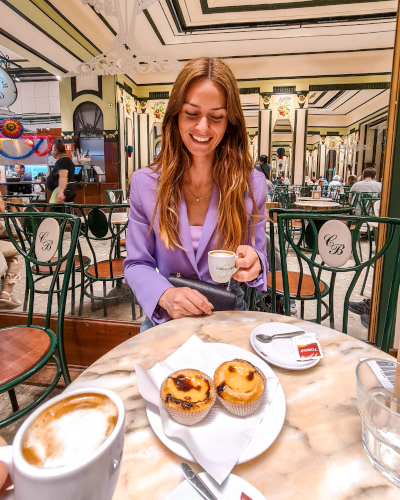
Coffee and Pastel de Natas in Confeitaria do Bolhão
Unlike the prices at Majestic Café, Confeitaria do Bolhão isn’t expensive at all. They offer an espresso for only €0,75!
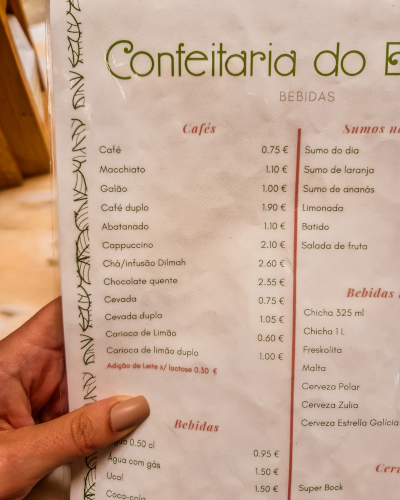
The prices of Confeitaria do Bolhão
Jardins do Palácio de Cristal
Jardins do Palácio de Cristal, or the Gardens of the Crystal Palace, is a public park just outside Porto’s city center. The gardens were designed in the 1860s by German landscaper Émile David, to surround the Crystal Palace that once stood on the site. In 1951, the Crystal Palace was replaced by the Rosa Mota Sports Pavilion. The gardens are lovely to walk around in and offer amazing views of the Douro River. We’d recommend simply strolling through the gardens while admiring the sights and views along the way. It’s a 15-minute walk from the Clérigos Tower to the gardens, but there is also a bus stop right in front of the entrance to the gardens.
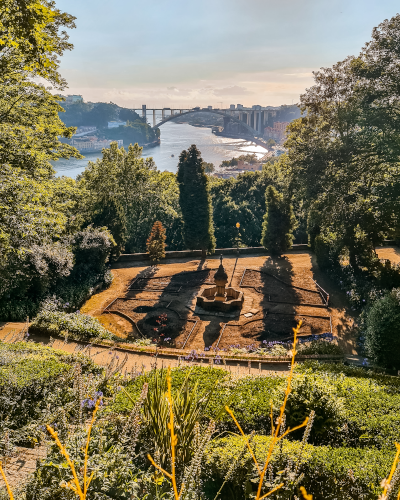
View of Ponte da Arrábida from Jardins do Palácio de Cristal
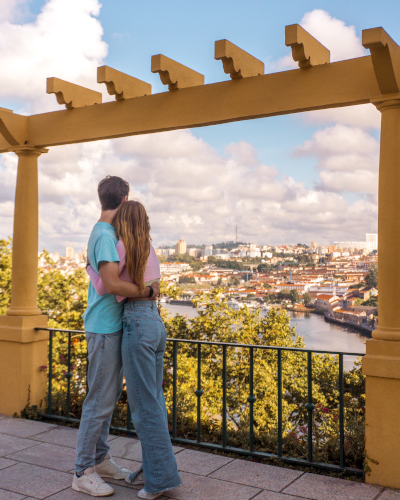
View of Vila Nova de Gaia from Jardins do Palácio de Cristal
Opening hours of Jardins do Palácio de Cristal
November - March: daily from 08:00 until 19:00
April - October: daily from 08:00 until 21:00
There’s no entrance fee.
Art Nouveau architecture in Porto
Besides Majestic Café, Porto is home to many more Art Nouveau as well as Art Deco buildings. The Art Nouveau and Art Deco architecture in Porto flourished in the beginning of the 20th century, when the city experienced a period of economic growth. We loved stumbling upon all these interesting architectural buildings, so keep your eyes peeled when strolling through the city!

Art Nouveau facade on Rua de 31 de Janeiro 174
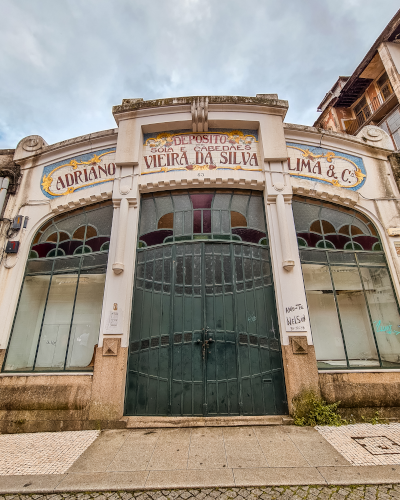
Art Nouveau building on Rua do Ateneu Comercial do Porto 41
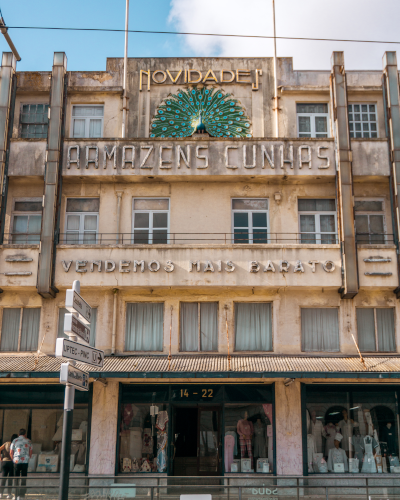
Art Deco building on Praça de Gomes Teixeira 14
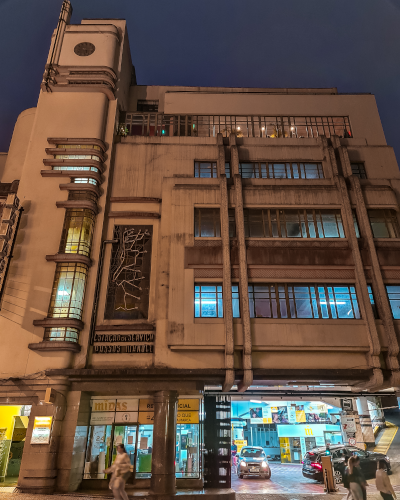
Art Deco building on Rua de Passos Manuel 176
If you’re interested in Art Nouveau architecture, you might also be interested in visiting Nancy in France, a true paradise for Art Nouveau lovers!
How long to stay in Porto
We stayed in Porto for four nights, which is great if you want to see the highlights of the city. We spent one of our days in Aveiro and Costa Nova do Prado, which is around a 1-hour drive from Porto, so we basically had three days in Porto. It wouldn’t hurt staying a few days longer because there are still plenty of things to do and see that we didn’t have time for. In our opinion, you could easily spend nearly a week in Porto, which allows you to visit Porto’s seaside district Foz do Douro, visit Parque de Serralves, visit Palácio da Bolsa, do a wine tasting at one of Gaia’s winemakers, visit the World of Wine and eat at more local restaurants. We have to save all those things for next time.
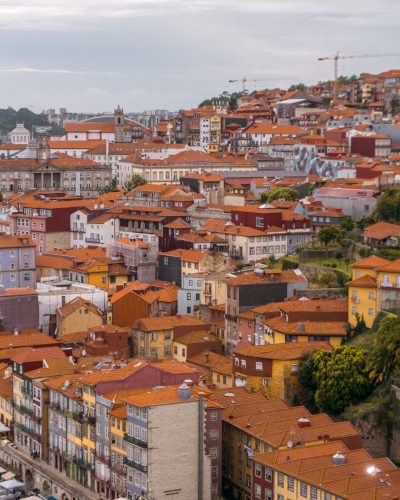
Where to stay in Porto
We stayed at Ibis Porto Centro São Bento, which is located in the Bolhão neighborhood right in the city center. The location of the hotel was perfect with Rua de Santa Catarina and Capela das Almas only steps away from the hotel and plenty of restaurants and cafés in the Bolhão neighborhood. The hotel has an arrangement with the next door’s car park, which was very convenient for us as we were traveling by car. Ibis Porto Centro São Bento is a reasonably priced hotel with simple but clean rooms equipped with everything you need for a few days in the city. We highly recommend this hotel if that’s what you’re looking for.
Click here to book a room in ibis Porto Centro São Bento.
Click here for more accommodation options in Porto.

We hope this guide to the best things to do in Porto has inspired you to visit this beautiful city and discover all it has to offer. From strolling along the Douro River to exploring the historic center and the stunning Azulejos-decorated buildings, there’s no shortage of attractions and beautiful sights to enjoy. So book your trip, pack your bags, and get ready to fall in love with Porto.
Have you been to Porto or is it still on your travel bucket list? Let us know in the comments below!
Be sure to check out:
- our online prints store KIPAVISTA.com
- our daily life updates on Instagram
- our YouTube Channel
- our TikTok
More Destinations
3-Day Road Trip along the Coast of Normandy
Visiting the Thermal Hot Springs in Saturnia, Tuscany
The Most Instagrammable Places in Madrid
How To Get Close To the Pink Lakes in the South of France
Camping in South West France: A Summer Getaway in Montalivet-les-Bains

